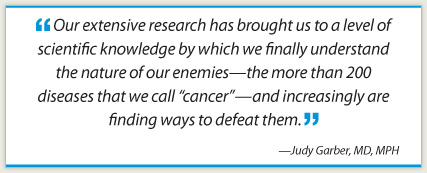American Association for Cancer Research (AACR) President and ASCO member Judy Garber, MD, MPH, recently spoke with The ASCO Post about the findings of AACR’s landmark Cancer Progress Report,1 In addition, she offered her perspective on the current and future state of cancer research.
 Project Origins
Project Origins
What was the genesis of the Progress Report?
It started as an idea to commemorate the anniversary of the National Cancer Act of 1971, and to summarize the progress over the ensuing decades. Then–AACR President Elizabeth Blackburn, PhD, and a group of people from various sectors of the community began with a think tank of sorts, from which a working group coalesced. An e-mail Q&A, categorizing the most important discoveries and challenges in cancer research and care, was sent to a larger group of AACR members. A series of comments and drafts were circulated, and the working group, along with AACR staff and leadership, hammered all the data into the finished report.
Moving Research Forward
The Progress Report cited the need for more and better computational and statistical tools to aggregate and stimulate the data into clinical action. Where are we in regard to filling that need?
We already have many of the analytic and statistical tools needed to move research forward. For instance, there are ongoing large-scale genomic analyses and informational projects that require computational biology efforts. Fortunately there are people with these special statistical and computational skills to move state-of-the-art research forward; the problem is that there are not enough of them.
Every research center in the nation faces the same dilemma—how to find more bright people doing large-set data analyses to turn their talents toward cancer biology. We need to recruit people internationally and from different disciplines such as engineering and aerospace who think in terms of massive data sets and are willing to use those skills to drill down into oncology data and give us the answers we need.
Behavior-related Cancers
The Progress Report notes that more than 50% of all cancer cases are behavior-related. Are we learning how to address that staggering statistic in ways that will substantially decrease preventable cancers?
For one thing, as the Progress Report pointed out, the reduction in tobacco use in this nation over the past several decades is a remarkable accomplishment. That said, we still have a long way to go. As a scientific community, we have struggled to find creative methods of prevention that engage people in a way that is meaningful on a long-term basis.
Other behaviors remain more difficult to modify. For example, it is a complex challenge to educate the public regarding sustained dietary modifications and even more difficult to address our national epidemic of obesity for many health reasons, of which cancer prevention is only one. We have not really tackled recreational sun exposure and continue to struggle to make occupational and environmental exposures national priorities. For those exposures that individuals can self-regulate, more research is needed to finds ways to maximize behavior modification.
Cancer Resarch in Hard Economic Times
The Progress Report’s call for more research funding has an almost desperate tone. Do you think cancer research is in jeopardy?
Cutting-edge clinical research calls for very expensive technology, but we need these technologies to increase the pace of progress. Since the National Cancer Act was signed into law in 1971, we haven’t faced a real cut in cancer research funding. Yes, we’ve had functional cuts—that is, even if the research budget remained flat we have incrementally lost purchasing power due to inflation and increasing operational costs. However, we’re now facing an 11% cut to cancer research funding, and more cuts are on the table. That means fewer grants, which translates into slower progress.
To put this in perspective, it’s worth noting that NIH allocates approximately 60% of its budget to research, compared with 15% in the private sector. Many people do not understand that the newest and best treatments often originate from basic and translational discoveries that are made when researchers across the investigative spectrum—basic, clinical, and translational—work together. We need the whole team to make progress at the rapid rates our patients need and deserve.
We want to offer our patients the most effective and least toxic treatments, and we can actually see these new therapies coming out of the pipeline. Unfortunately, without the necessary funding, that progress is going to slow to a trickle.
Convincing Policymakers
How do we meet that need in an era of declining NIH and NCI budgets?
 To begin with, by being more persuasive. Many leaders from AACR and ASCO participated in last year’s Hill Day—an annual day of meetings with members of Congress and congressional aides to emphasize the importance of increased federal funding for cancer research. What we were told by members of Congress is that we are not marketing the full force of cancer research very well.
To begin with, by being more persuasive. Many leaders from AACR and ASCO participated in last year’s Hill Day—an annual day of meetings with members of Congress and congressional aides to emphasize the importance of increased federal funding for cancer research. What we were told by members of Congress is that we are not marketing the full force of cancer research very well.
Many people in Congress don’t truly understand what the NCI does; they think all the money stays in Bethesda, not realizing that funding research has a positive impact in their hometowns. Moreover, cancer research funding has a positive economic impact on local economies by bringing in high-value employment opportunities and support industries.
Policymakers don’t quite grasp the concept that all the progress we’ve made developing lifesaving treatments being delivered in community practices across the country are the result of 40 years of cancer research. We’ve come to a paradox of sorts, because policymakers don’t want cancer progress to slow down, but they also are reluctant to pay for it during a time of economic challenges.
So it’s become part of our job to elucidate the overall benefits of investment in cancer research, not just on Capitol Hill, but also to the general public. After all, cancer affects everyone across the nation.
Bottom Line
What is the most important takeaway message from the Progress Report?
I’d say it’s the emphasis on how federally funded research for cancer has had a tremendous payoff in lives extended and saved. Our extensive research has brought us to a level of scientific knowledge by which we finally understand the nature of our enemies—the more than 200 diseases that we call “cancer”—and increasingly are finding ways to defeat them.
As a result, we are currently at a defining moment in our ability to detect, prevent, manage, and cure cancers. We have evidence that the new, targeted drugs work just as we anticipated they would. And the energy from this progress should be directed at removing cancer as a major health threat.
To turn that goal into reality, the AACR respectfully recommends that Congress provide the NIH and NCI with annual budget increases of at least 5% above the biomedical inflation rate. Without investment in research, we risk stalling the exponential progress we have already made. ■
Disclosure: Dr. Garber reported no potential conflicts of interest.
Reference
1. American Association for Cancer Research: AACR Cancer Progress Report 2011: Transforming Patient Care through Innovation. Available at www.cancerprogressreport.org. Accessed January 23, 2012.

